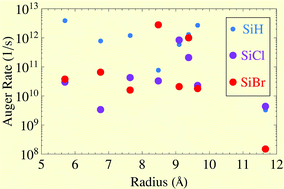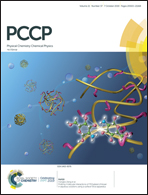Effects of surface halogenation on exciton relaxation in Si crystallites: prospects for photovoltaics
Abstract
Ab initio study of Si crystallites (diameter: 1.1–2.4 nm) with fully Cl- or Br-passivated surfaces was performed. It was shown that halogenation straightens the band structure of such small Si nanocrystals in the momentum space, but it strongly separates the electron densities of states above and below the fundamental gap in real space. This causes a substantial slowdown (up to several orders of magnitude in the rates as compared to those in H-passivated nanocrystals) of the radiative electron–hole transitions, the rates of which were computed by using time-dependent density functional theory calculations. A similar effect takes place for Auger recombination—the rates of the Auger process become one–two orders of magnitude smaller as compared to those observed with hydrogen passivation. In contrast to radiative and Auger recombinations, the process of multiexciton generation is not, in fact, strongly affected by halogen surface passivation. This yields an essential rise in the internal quantum efficiency (up to the values close to 2 at its maximum) of multiexciton generation. This rise facilitates the consideration of halogenated Si nanocrystals as very attractive tools for photovoltaics applications.



 Please wait while we load your content...
Please wait while we load your content...